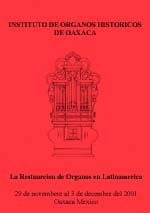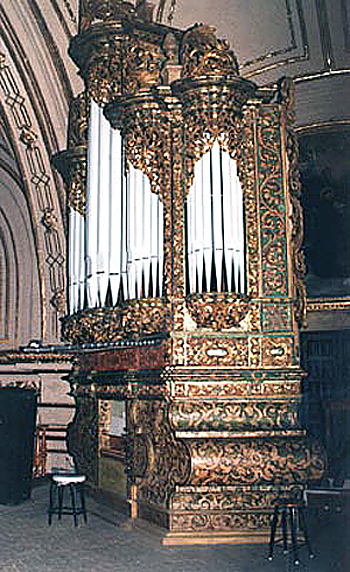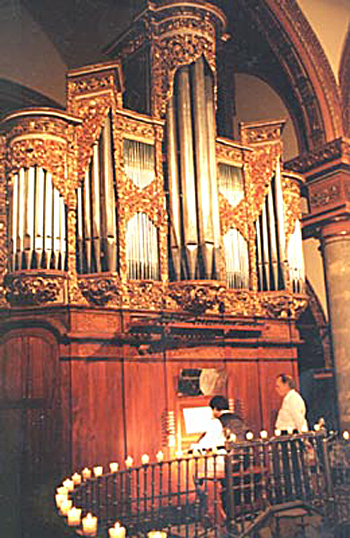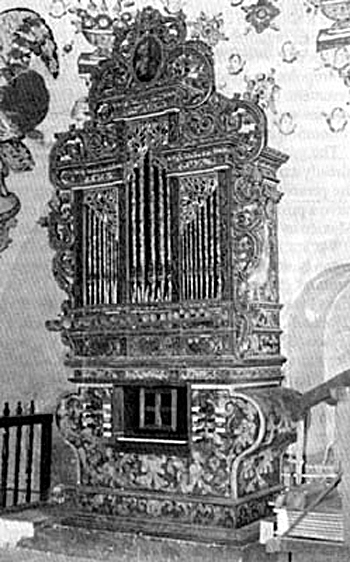 |
||
|
|
|
Celebrating the pipe organ, the King of Instruments |
Pipedreams Oaxacan Holiday
Program ![]() #0242 October 2002
#0242 October 2002
taken from the Festival Internacional de Música para Órganos Oaxaca-México - 2001
Michael Barone’s personal slideshow:
![]() Slideshow part 1 |
Slideshow part 1 | ![]() Slideshow part 2 |
Slideshow part 2 | ![]() Slideshow part 3
Slideshow part 3
From the conference
![]() Letter from the Director |
Letter from the Director | ![]() Oaxaca Protocol 2001
Oaxaca Protocol 2001
Restored organs:
![]() LA BASÍLICA DE LA SOLEDAD |
LA BASÍLICA DE LA SOLEDAD | ![]() CATHEDRAL, Oaxaca City |
CATHEDRAL, Oaxaca City | ![]() SAN JERÓNIMO TLACOCHAHUAYA
SAN JERÓNIMO TLACOCHAHUAYA
Letter from the Director & Sub-Director the Instituto de Órganos Históricos de Oaxaca
 (taken from the conference booklet.)
(taken from the conference booklet.)
The southeastern state of Oaxaca, Mexico, houses one of the world’s great treasures of historic pipe organs, and so far fifty one instruments, built between approximately 1680-1900, have been located in the state. Six of these have been restored and are now playable (located in San Jerónimo Tlacochahuaya, San Andrés Zautla, Santa María de la Natividad Tamazulapan, the Oaxaca Cathedral, Santo Domingo Yanhuitlán, and La Basílica de la Soledad) and a seventh restoration (Santa María de la Asunción Tlaxiaco) is in process.
To protect this legacy, the Instituto de Órganos Históricos de Oaxaca (IOHIO, pronounced yo-yo) was established in the year 2000 by Cicely Winter, pianist, harpsichordist and permanent Oaxaca resident since 1972, and Edward Pepe, organist, co-founder of the Westfield Center for Early Keyboard Studies and now part-time Oaxaca resident. The IOHIO functions in coordination with el Instituto Nacional de Antropología e Historia (INAH), the officials of the towns with organs, the ecclesiastical authorities, the directors of the archives in Oaxaca and other organists in Mexico. The office of the IOHIO is located in the building of the Museo de Filatelia de Oaxaca (MUFI) in Oaxaca City.
Many areas of Mexico have a rich organ-building tradition, but none surpasses that of Oaxaca. These organs, originally constructed according to Spanish models, eventually evolved to incorporate elements unique to Oaxaca. They typically have one keyboard with forty-five keys (about half the length of a modern piano keyboard) and no pedals, and they are tuned according to a renaissance tuning system known as meantone and sound a whole tone lower than modern pitch. Some of the Oaxacan organs create a visual impact as dramatic as that of their sound. Their ornately painted cases integrate multicolored floral designs with images of angels playing instruments, archangels or saints; their pipes are painted and decorated with human faces in which the mouth is formed by the pipe opening; and their cases are elaborately carved and shaped with non-utilitarian bulges (“hips”) on the sides. The brilliant sound, characteristic of Spanish organs, is enhanced by a rank of horizontal trumpets extending from the front of the case. These organs allow us to hear Spanish baroque music as it may have sounded hundreds of years ago in Oaxaca.
The Institute’s long term goals are:
1. Increase public awareness of the Oaxaca organs through concert, recordings, research and publications.
2. Maintain the restored organs, protect the unrestored organs and support future restoration projects.
3. Assure that the restored organs are played in both liturgical and concert settings. The IOHIO intends to contract a young Mexican organist to play and maintain the organs on a regular basis.
4. Establish a research facility for local and visiting scholars and performers.
5. Sponsor events to foster national and international interest in the Oaxaca organs: an international festival of organ music, conferences, master classes, tours, festivals and a permanent exhibit.
6. Establish a choral and keyboard school in Oaxaca.
7. Establish a restoration and organ building shop in Oaxaca.
The local and international response to the Instituto de Órganos Históricos de Oaxaca has been overwhelmingly enthusiastic, and it is hoped that its activities will continue to generate the good will and excitement which these authentic baroque organs deserve.
Cicley Winter, Director
Edward C. Pepe, Sub-Director
Reforma 504
Colonia Centro
68000 Oaxaca, Mexico
Tel/Fax (9) 516 3956
iohio@spersaoaxaca.com.mx
OAXACA PROTOCOL 2001
Summary of Principles for the Conservation and Restoration of Organs in Latin America
1. There exist a great number of historically and arti stically important organs, some of which represent a unique synthesis of indigenous and European cultures. The organ is a multifaceted instrument that embodies many arts and crafts and, when properly conserved, allows one to imagine the voices of the past.
stically important organs, some of which represent a unique synthesis of indigenous and European cultures. The organ is a multifaceted instrument that embodies many arts and crafts and, when properly conserved, allows one to imagine the voices of the past.
2. For purposes of this document, an organ will be considered historic if it is fifty years of age or older.
3. There exists the need to foster standards and controls for the cataloguing, documentation, conservation, restoration, and maintenance of these instruments.
4. This protocol is the result of an international conference (“The Restoration of Organs in Latin America”) held November 29 to December 3, 2001 in Oaxaca, Mexico by the Instituto de Órganos Históricos de Oaxaca in cooperation with the Instituto Nacional de Antropología e História, the Instituto Nacional de Bellas Artes, the Consejo Nacional para la Cultura y las Artes, the Instituto Oaxaqueño de las Culturas, the embassies in México of Spain, France, The Netherlands, Uruguay and Switzerland, Pro-Helvetia, and the Amigos de Oaxaca Foundation.
5. All parties who deal with these organs must agree to abide by the Oaxaca Protocol 2001.
6. In cases where these principles cannot be observed, work on historic organs must not be undertaken.
Appendix A: Signatures of those who subscribe to this document.
Organ of LA BASÍLICA DE LA SOLEDAD, Oaxaca City
Date of Construction: Case - 1686, Organ c. 18th century.
Restored: 1997 by Pieter Visser with assistance of Ignacio Zapata (Gustavo Delgado para and Ofelia Gomez Castellanos, consultants)
Bass (21 notes)
Flautado Mayor [8′]
Bajoncillo (hor.) [4′] (new)
Flautado Bardón [8′]
Octava [4′]
Docena [2 2/3′]
Tapadillo (stopped) [4′]
Veintidocena [1′]
Quincena [2′]
Vientisesena [2/3′]
Tercia [1 3/5′]
Trompeta Real [8′]
Lleno [III] (new)
Flauto Mayor [8′]
Clarín (hor.) [8′] (new)
Flautado Bardón [8′]
Octava [4′]
Flauta [5 1/4′]
Quinta [5 1/3′]
Tapadillo (stopped) [4′]
Octava II [4′]
Quincena [2′]
Docena [2 2/3′]
Tierce [3 1/5′]
Octava III [4′]
Lleno [III] (new)
Quincena II [2′]
Trompeta Real [8′]
*The disposition is a reconstruction. The stop names are not original. There are no labels, so stop names are conjectural.
Organ of the CATHEDRAL, Oaxaca City
Date of Construction: 1788
Restored: 1997 by Susan Tattershall
Bass (21 notes)
Flautado [8′]
Trompeta Real [8′]
Lleno [III] (new)
Diez y Novena [1 1/3′]
Quincena [2′]
Octava [4′]
Flautado en 8 (stopped) [4′]
Bardón (stopped) [8′]
Tambor
Treble (26 notes)
Trompeta Real [8′]
Diez y Novena [1 1/3′]
Lleno [IV] (new)
Quincena [2′]
Flautado en 8 (open) [4′]
Bardón (stopped) [8′]
Corneta [IV]
Flautado [8′]
Clarín (hor.) [8′]
Pajaritos
*The Cathedral organ has been substantially altered over the course of its history. This disposition is a reconstruction based on Mexican and Spanish models. The stop names are also not original.
Organ of the SAN JERÓNIMO TLACOCHAHUAYA (Valles Centrales), Oaxaca
Date of Construction: unknown, possibly in the 17th century
Restored: 1991 by Susan Tattershall
Disposition
Bass (21 notes)
Flautado [4′]
Bajoncillo [4′ int. ] (1735?)
Octava [2′]
Quincena [1′]
Diez y Novena [2/3′]
Veintidocena [1/2′]/Quincena [1′]
Bardón [8′] (1753)
Treble (24 notes)
Trompeta en Batalla [8′] (1735?)
Flautado [4′]
Octava [2′]
Docena [1 1/3′]/Quinta [2 2/3′]
Flautado II [4′]
Octava II [2′]
Bardón [8′] (1735)
Pajaritos
*This disposition is a reconstruction based on Mexican and Spanish models. The stop names are also not original.




